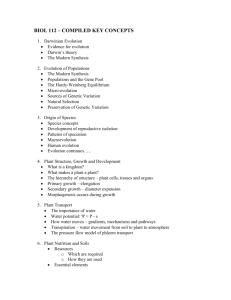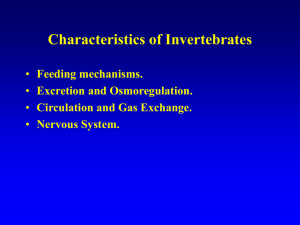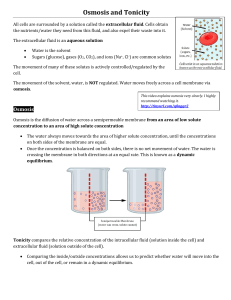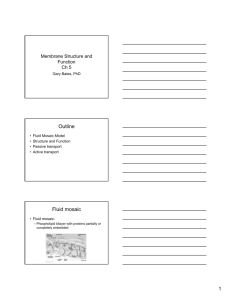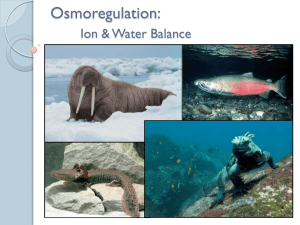15 - Osmoregulation & Excretion
advertisement
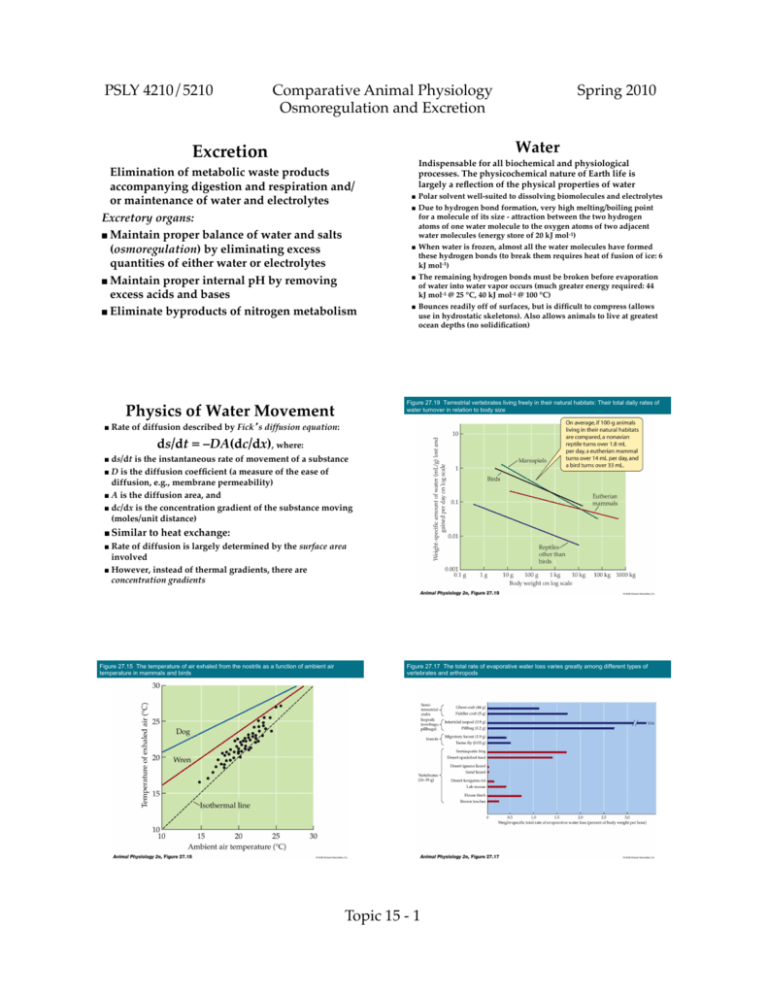
PSLY 4210/5210 !Comparative Animal Physiology !Osmoregulation and Excretion! Water! Excretion! !Indispensable for all biochemical and physiological processes. The physicochemical nature of Earth life is largely a reflection of the physical properties of water! !Elimination of metabolic waste products accompanying digestion and respiration and/ or maintenance of water and electrolytes ! Excretory organs:! Maintain proper balance of water and salts (osmoregulation) by eliminating excess quantities of either water or electrolytes! Maintain proper internal pH by removing excess acids and bases! Eliminate byproducts of nitrogen metabolism! Polar solvent well-suited to dissolving biomolecules and electrolytes! Due to hydrogen bond formation, very high melting/boiling point for a molecule of its size - attraction between the two hydrogen atoms of one water molecule to the oxygen atoms of two adjacent water molecules (energy store of 20 kJ mol-1)! When water is frozen, almost all the water molecules have formed these hydrogen bonds (to break them requires heat of fusion of ice: 6 kJ mol-1)! The remaining hydrogen bonds must be broken before evaporation of water into water vapor occurs (much greater energy required: 44 kJ mol-1 @ 25 °C, 40 kJ mol-1 @ 100 °C)! Bounces readily off of surfaces, but is difficult to compress (allows use in hydrostatic skeletons). Also allows animals to live at greatest ocean depths (no solidification)! Figure 27.19 Terrestrial vertebrates living freely in their natural habitats: Their total daily rates of water turnover in relation to body size Physics of Water Movement! !Spring 2010! Rate of diffusion described by Fick s diffusion equation:! ds/dt = –DA(dc/dx),! where:! ds/dt is the instantaneous rate of movement of a substance! D is the diffusion coefficient (a measure of the ease of diffusion, e.g., membrane permeability)! A is the diffusion area, and! dc/dx is the concentration gradient of the substance moving (moles/unit distance)! Similar to heat exchange:! Rate of diffusion is largely determined by the surface area involved! However, instead of thermal gradients, there are concentration gradients! Figure 27.15 The temperature of air exhaled from the nostrils as a function of ambient air temperature in mammals and birds Figure 27.17 The total rate of evaporative water loss varies greatly among different types of vertebrates and arthropods Topic 15 - 1! PSLY 4210/5210 !Comparative Animal Physiology !Osmoregulation and Excretion! Osmosis! !Spring 2010! Figure 26.8 The fundamental principles of cell volume regulation !Movement of a solvent (i.e., water) between solutions:" ! " " " ! Two solutions separated by a thin and semipermeable membrane: solvent can pass through but solutes cannot (or not as readily)! Because of high water concentration on the left-hand side, the number of random collisions of the water molecules with the membrane per unit area and per unit time will be greater on the left side than on the right! Net flow of water will be from low to high solute concentration! Osmotic flow often exceeds diffusion due to facilitated diffusion mechanisms and active transport (e.g., exocytosis)! Human Blood/Tissue Composition! Ionic and Osmotic Balance! Life requires that appropriate quantities of both water and solutes be maintained in both the extracellular and intracellular body compartments! Life evolved several billion years ago in shallow, salty seas. Concentrations of extracellular fluids likely reflect the osmotic conditions of that environment! The ability to regulate internal osmotic environment that is possessed by more advanced forms of life is an important evolutionary trait! Buffers the tissues from abrupt changes in environmental conditions and increasing the efficiency of metabolism by maintaining homeostasis! Animals are restricted in their geographic distribution by their osmotic requirements! Maintenance of internal osmotic environment allowed colonization of freshwater and terrestrial habitats! Problems of Osmoregulation! Figure 26.2 The three major types of body fluids are closely juxtaposed Because of oxygen and waste elimination needs, animals must be able to exchange materials with the environment! Exchanges of water and ions accompany these! Some tissues require an extracellular ionic environment that is an approximation of seawater! High Na+ and Cl–! Low in other major ions, e.g., K+ and divalent cations! For many marine animals, seawater (1000 mosmol kg-1) can act as the extracellular medium! However, vertebrates (except for hagfishes) have an ionic concentration about 1/3 (300 mosmol kg-1) that of seawater! Also, much of the MgSO4 is removed, and some of the Cl– is replaced by HCO3– ! Reflects their freshwater origin (including marine teleosts)! Topic 15 - 2! PSLY 4210/5210 !Comparative Animal Physiology !Osmoregulation and Excretion! Terminology! !Spring 2010! Osmotic Strength of Aquatic Environments! Concentration of solutions almost always expressed in molarity (moles of solute/liter of solvent)! Occasionally expressed in molality (1 molal = 1 mole of solute dissolved in 1 kg of solvent)! Environment Little difference in dilute aqueous solutions, but significant difference in concentrated solutions! Osmotic concentrations in tissue fluids of animals are often expressed in osmoles (1 molal = 1 osmol)! Because osmotic activity depends on the number of particles in solution, osmolality depends on the molality of the solution as well as to the extent to which the solute dissociates! For NaCl, for example, the osmolality is 2× the molality, although in practice the dissociation is never complete! Generally measured indirectly by measuring another colligative property (e.g., depression of vapor pressure or freezing point)! ! ! ! ! !(mmoles/kg)" !Na ! Cl !Ca !K !Mg !sulfate !bicarbonate! soft lake water !0.17 !0.03 !0.22 !– !0.15 !0.09 !0.43! river water !0.39 !0.23 !0.52 !0.04 !0.15 !0.21 !1.11! hard river water !6.13 !13.44 !5.01 !0.11 !0.15 !1.40 !1.39! seawater !470.2 !548.3 !10.23 !9.96 !53.57 !28.25 !2.3! Bad Water !640 !630 !32 !16 !0.15 !54 !3.00" (Death Valley)! Dead Sea !840 !6662 !583 !152 !0.15 !8.4 !trace! Major Inorganic Ions of Tissues! Ion Na+ K+ Ca2+ Mg2+ HPO42–; HCO3– Cl– !Distribution !Main extracellular cation ! ! ! ! !Main cytosolic cation ! ! ! !Low concentration in cells ! ! ! ! !Intra- and extracellular ! !Intra- and extracellular !Main extracellular anion !of tissues! Osmotic Strength in Animals! ! Major Functions! !Is major source of osmotic pressure." !Provides potential energy for" !transport of substances across cell" !membranes. Provides inward current" !for membrane excitation! !Is source of cytosolic osmotic" !pressure. Establishes resting" !potential. Provides outward current" !for membrane repolarization! !Regulates exocytosis and muscle" !contraction. Is involved in" ! cementing cells together. Regulates" !many enzymes and other cell" !proteins, acts as second messenger! !Acts as cofactor for many enzymes" !(e.g., ATPases)! !Buffers H+ concentration! !Is counter-anion for inorganic cations Osmoregulation/Osmoconformity" in Aquatic Animals! Terrestrial animals adjust internal ionic environment in response to desiccation, but not in response to osmotic inflow of water! Aquatic (freshwater and marine) animals must deal with ionic diffusion, as well as diffusion of water, between the animal and the fluid medium! Osmotic strength of animal body fluids:! Isosmotic animals ( ionic conformists ) - regulate ionic ratios only! Hyperosmotic animals - maintain a high body solute concentration compared with concentrations in the environment! Hyposmotic animals - maintain a low body solute concentration compared with concentrations in the environment! Figure 27.10 Types of osmotic regulation Strict osmoconformers - always have an internal osmolarity" that is the same as the medium in which they are immersed! Strict" Internal-" Limited osmoregulators -" osmo-" external" maintain an internal" conformer! osmoequality! osmolarity different" from the medium in" SW eurywhich they are" Osmolarity" FW euryhaline fish! of" immersed, but can" haline fish! Body" do so only over a" Fluid! limited range! Strict osmoregulators -" Limited" Strict" osmo-" osmoregulator" maintain an internal" regulator! (stenohaline fish)! osmolarity different from" Osmolarity of the Environment! the medium in which they" are immersed! Topic 15 - 3! PSLY 4210/5210 !Comparative Animal Physiology !Osmoregulation and Excretion! Intra/Extracellular Osmoregulation! Intracellular environment of most animals is low in Na+, but high in K+, HPO42–, and proteins! There are only minor and transient osmotic differences between the intracellular and extracellular fluids of animals! Thus, the cell membrane maintains ionic, but not osmotic differences between the intracellular and extracellular fluids! In contrast, the epithelium surrounding the body often maintains both ionic and osmotic differences between the animal and its environment! In most animals, entire body surface does not participate in ionic and osmotic regulation! Instead, specialized body surfaces (e.g., gills) or internal organs (e.g., kidneys, salt glands) regulate salt and water! Osmoregulatory Mechanisms! Hober (1902): handle osmotic problems and regulate the differences between:! Water enters with food and drink (terrestrial and marine animals) or through respiratory epithelium or integument (freshwater animals)! Water leaves in urine, feces, and by evaporation from lungs and integument! Osmotic Exchanges! Examples: trans-epithelial diffusion, ingestion, egestion, metabolic water production! Regulated osmotic exchanges - physiologically controlled and serve to maintain homeostasis! Two classes of osmotic exchanges between an animal and its environment:! Obligatory Exchanges of Ions and Water! Obligatory osmotic exchanges - occur mainly in response to physical factors over which the animal has little or no physiological control! Example: active epithelial transport! Compensate for obligatory exchanges! Influenced by same factors:! Fluxes across membranes determined by concentration gradients, surface area of membrane, thickness of membrane (diffusion distance)! Small animals will dehydrate or hydrate more rapidly (and must expend more energy on active regulatory processes)! !Permeability of the integument - barrier between the extracellular compartment and the environment! Movement of water occurs between cells (paracellular) and through cells (transcellular)! Pure phospholipid bilayers not very water-permeable: transcellular movement depends on presence of protein water channels (e.g., aquaporin, a tetramer which forms a channel through the plasma membranes of many animal cells)! Water exchange rates vary greatly among animal taxa: low in reptiles, birds, and mammals, high in fishes and amphibians (also have active transport of salts through skin and gills). Amphibians have other water-retaining adaptations: ! Water is an end product of cellular metabolism of food. Produced in small enough quantities that elimination is no problem (actually the major source of water for desert animals):" !carbohydrates !g metabolic !0.56 water/g food! !kJ expended/ !17.58 g food! !g metabolic !0.032 water/kJ expended! !fats !1.07 !proteins! !0.40" !39.94 !17.54" !0.027 !0.023" In terrestrial animals, regulation of plasma ion concentrations and elimination of metabolic wastes is accompanied by unavoidable water losses:! Insects and arachnids are particularly efficient at conserving water while eliminating nitrogenous and inorganic wastes! Can absorb ions via the rectum or eliminate them in feces! In vertebrates (especially mammals, which have no other organs for this purpose), the kidney is the main osmoregulatory (and nitrogen excretion) organ! Diet may contain excess water or salts: need to eliminate excess salts and nitrogenous wastes! Example: seals become fat eating fish but thin eating invertebrates! Can reabsorb water, Na+, and Cl– from urinary bladder! Pelvic patches (highly absorbent skin on underside of pelvis)! Hormonal (arginine vasotocin) control over skin permeability! Toads have microchannels through skin to soak up water! Excretory Water Losses! Feeding and Metabolic Water Production! Intracellular and extracellular compartments! Extracellular compartment and the environment! May be hourly or daily variations, but generally animal is at long-term steady-state (inputs and outputs of water and salts are equal)! !Spring 2010! Invertebrates have similar salt content to seawater, fish are less salty! Seal burns fat to produce both energy and water (to excrete excess salt) when feeding in invertebrates, but stores fat when eating fish ! Topic 15 - 4! Kidneys of birds and mammals utilize countercurrent multiplication to produce a hyperosmotic urine that is more concentrated than plasma! Specialization (loop of Henle) of individual nephrons which allows terrestrial existence. Reaches its highest level in desert animals (e.g., kangaroo rats). Less efficient in birds, absent in other vertebrates! PSLY 4210/5210 !Comparative Animal Physiology !Osmoregulation and Excretion! Figure 27.23 An index of water balance: Metabolic water production (MWP) as a ratio of total evaporative water loss (EWL) Figure 27.22 A kangaroo rat water budget Summary of Desert Adaptations in the" Kangaroo Rat (Dipodemys merriami)! Water Balance in the kangaroo rat! Don t sweat! ! !90% !10% !0% !Water Losses! !Evaporation !Urine !Feces !70%! !25%! !5%! Osmoregulation/Osmoconformity! Lose less water in feces than other rodents (3× less than rats)! Urinates in burrow to increase relative humidity! Lose less water in respiration! Complicated nasal passages increase turbulence, slows down expired air and allows it to cool. Moisture condenses on surfaces of nasal passages, drips down throat, and is swallowed.! Figure 26.3 Osmotic regulation and conformity Osmoregulators maintain strict extracellular homeostasis in the face of large environmental variation in electrolyte concentrations! Internal tissues are generally unable to cope with more than minor changes in extracellular osmolarity! Cells must depend entirely on osmotic regulation of extracellular fluid to maintain cell volume! Water obtained from metabolizing food! Water collected on surface of food (at high humidity, up to 6× the amount of water available in the food)! Increased water retention! " Evaporative cooling from lungs? Not at reasonable temperatures! Don t seem to lose water under heat stress! Don t drink! Water Gains Metabolic water Free water in dry food Drinking !Spring 2010! Osmoconformers demonstrate a high degrees of intracellular osmotic tolerance! Cells can cope with high plasma osmolarities by increasing their intracellular osmolarities using organic molecules, thus increasing total osmolarity and maintaining cell volume! This reduces the need to maintain osmotic pressure with other substances (e.g., ions) that would produce other physiological problems (e.g., changes in protein conformation)! Topic 15 - 5! PSLY 4210/5210 !Comparative Animal Physiology !Osmoregulation and Excretion! Figure 26.9 Many animal cells achieve cell volume regulation principally by altering their content of organic solute molecules !Spring 2010! Organic Osmolytes! In some marine invertebrates and vertebrates, organic osmolytes also are present in the blood and interstitial fluids, as well as inside cells! Thus, both intracellular and extracellular osmolarity are close to seawater! Best-known examples are urea and trimethylamine oxide (TMAO)! Urea tends to cause dissociation of multi-subunit proteins! TMAO reduces this dissociation! Both used by marine elasmobranchs, chimeras (Holocephali), the coelacanth (Latimeria chalumnae), and the brackish-water crab-eating frog Rana cancrivora! General Patterns of Water and Salt" Regulation in Marine Animals! Figure 26.10 Counteracting solutes in a stingray !Liability to ! Liability to !Blood conc !Urine conc" !osmotic ! evaporative !relative to !relative to" !water loss ! water loss !medium conc !medium conc! Marine !– !– (+++ if !isotonic !isotonic" invertebrates ! !intertidal) " No osmoregulation! Elasmobranchs !– !– !isotonic !isotonic" Do not drink; excrete hypertonic NaCl from rectal gland! SW teleosts !+ !– !hypotonic !isotonic" Drink copiously; excrete NaCl from gills! FW teleosts !_ !– !hypertonic !hypotonic" Do not drink; produce large amount of very dilute urine! Sea turtles !_ !+ !hypotonic ! isotonic " Drink seawater; produce hypertonic tears ! Seabirds !_ !+++ !hypotonic ! hypertonic" Drink seawater; produce hypertonic nasal secretion; weakly hypertonic urine! Marine !_ !+ !hypotonic ! hypertonic" mammals " Do not drink; produce strongly hypertonic urine! Animal Figure 28.5 Major solute and water fluxes in the late distal convoluted tubule during diuresis and antidiuresis Figure 28.6 The human kidney, emphasizing the nephrons and their blood supply (Part 1) Topic 15 - 6! PSLY 4210/5210 !Comparative Animal Physiology !Osmoregulation and Excretion! !Spring 2010! Figure 28.6 The human kidney, emphasizing the nephrons and their blood supply (Part 2) Figure 28.1 The structural and functional basis for formation of primary urine by ultrafiltration in the vertebrate kidney Figure 28.2 Formation of primary urine by active solute secretion Figure 28.16 Major molecular mechanisms of NaCl reabsorption and associated processes in three parts of the mammalian kidney tubule Nephron Function! Figure 28.6 The human kidney, emphasizing the nephrons and their blood supply (Part 2) Topic 15 - 7! PSLY 4210/5210 !Comparative Animal Physiology !Osmoregulation and Excretion! !Spring 2010! Figure 28.12 Countercurrent multiplication in the loop of Henle Figure 28.6 The human kidney, emphasizing the nephrons and their blood supply (Part 2) Figure 27.18 Urine concentrating ability in mammals: The maximum concentration is in part a function of body size Figure 28.7 Evolutionary development of the renal papilla in mammals native to different habitats Figure 28.8 Maximum urine concentration correlates with the relative thickness of the medulla Figure 28.9 The relation between relative medullary thickness and body size depends on whether mammals are native to arid, mesic, or aquatic habitats Topic 15 - 8! PSLY 4210/5210 !Comparative Animal Physiology !Osmoregulation and Excretion! Non-mammalian Vertebrate Kidneys! Non-mammalian Vertebrate Kidneys! Nephrons of hagfishes possess glomeruli, but no tubules: Bowman s capsules empty directly into collecting ducts! Freshwater teleosts have larger and more abundant glomeruli than marine teleosts! Some marine teleosts are aglomerular (lack both glomeruli and Bowman s capsules)! Osmoconformers: Extracellular fluids almost identical to seawater! Kidneys are used largely to excrete divalent cations (Ca2+, Mg2+, SO42–). Little or no osmoregulation! The elasmobranchs have a complex tubule organization that should allow countercurrent multiplication! Unlike mammalian kidney (which excretes urea and retains water to produce a hypertonic urine), this structure retains urea and does not produce a concentrated urine! Appears to be an adaptation to conserve urea for use as an osmolyte. The freshwater skate Raja erinacea does not reabsorb filtered urea, and its kidneys lack these tubular bundles, indicating that these structures are the site of urea absorption! Urine formed entirely by secretion, because no specialized mechanism to produce a filtrate! Amphibians and reptiles lack countercurrent loop of Henle! Figure 28.3 Amphibian nephrons and their connections to collecting ducts !Spring 2010! Incapable of producing hyperosmotic urine relative to plasma! Birds have a mixture of reptilian-type and mammaliantype nephrons! Some nephrons lack a loop of Henle! In some birds, the loop is located perpendicular to the collecting duct: less efficient concentrating mechanism! Figure 28.4 Urine formation in amphibians during diuresis Extrarenal Osmoregulatory Organs! Figure 28.19 A lobe of a bird s kidney in cross section Found in a variety of animals:! Rectal glands (elasmobranchs)! Nasal salt glands (birds and reptiles) , also tongue of crocodilians! Gills of teleosts! Common feature is the presence of epithelial chloride cells! These cells have extensive, folded basolateral (serosal) membrane, with much larger surface area ( brush border ) than that of the apical (mucosal) membrane! Many mitochondria - lots of active transport! Cells excrete salt in a manner similar to Na-absorbing cells in kidney, but! Blood is not filtered - salt is removed from ECF! Often these cells form a large number of blind-ending tubules that drain into a duct, which opens into a lumen that is exposed to the environment! Topic 15 - 9! PSLY 4210/5210 !Comparative Animal Physiology !Osmoregulation and Excretion! Teleostean Gill Structure! The branchial apparatus of teleosteans consists of four pairs of gill arches, each with two rows of projecting filaments! The lamellae extend as flattened leaflets from each side of the filament! Also shown: afferent (a.v.)" and efferent (e.v.)" vessels with" erythrocytes" (r.c.); cartilaginous" spine supporting" the filament (c.);" central vascular" compartment (c.c.);" mucous cell (m.c.);" chloride cell (ch.);" pavement or pillar cells (p.c.)! !Spring 2010! Teleostean Gill Cells! Osmotic liability: large surface area in contact with water. Epithelium separating blood from water consists of several cell types:! Pavement (or pillar) cells! Chloride cells! Flat (3-5 mm thick)! Some mitochondria! Minimal barrier to diffusion: used for gas exchange! Thicker and more columnar in shape! Deeply infolded! Many mitochondria and active salt transport enzymes! Tight junctions joining these to chloride cells! Mucous cells! Secrete protective film of mucus! Figure 27.2 Ion exchanges mediated by active Na+ and Cl– transport in the gill epithelium of freshwater teleost fish Salt Cell Function! + –! Seawater" (or gland" lumen)! ECF! K+! K+! Na+/K+ ATPase! Na+! Cl–! Na+! –! Apical" (mucosal) membrane! Figure 27.6 A section of a chloride cell of a marine teleost fish The apical pit (or apical crypt) characterizes these cells in seawater-adapted fishes! + Na+! Na+/2 Cl–/K+ 2 Cl–! cotransport K+! enzyme! Basolateral" (serosal) membrane! Salt Secretion by SW Teleosts! Chloride cells similar to those described earlier:! High levels of Na+/K+ ATPase associated with Na/2 Cl/K cotransporters in the basolateral membrane and Cl– channels in the apical membrane! Each is associated with an accessory cell (distinct from a pavement cell): Na+ diffuses from blood to seawater through the less tight paracellular channel between the chloride and accessory cell! Salt secretion occurs against an osmotic gradient, and there is no movement of water following the movement of salt! Also mediate the exchange of other ions, including Ca2+ (Ca2+ in water is taken up via Ca2+ channels in the apical membrane, and is then actively transported into the cells via large numbers of Ca2+ ATPase molecules in the basolateral membrane)! Topic 15 - 10! PSLY 4210/5210 !Comparative Animal Physiology !Osmoregulation and Excretion! Summary of Osmoregulation in" SW and FW Teleosts! Salt Uptake by FW Teleosts! Pavement cells have a proton (H+) ATPase and Na+ channels in the apical membrane! A Na+/K+ ATPase in the basolateral membrane pumps Na+ out of the cell into the blood, and K+ cycles through channels in the membrane! Gill epithelium also contains chloride cells, which also mediate the uptake of Ca2+ from the water. These are different from the chloride cells of marine teleosts:! Saltwater teleosts:! Drink seawater copiously! Pump salt into body - water follows! Pump out salt via gills! If you remove too much salt, water follows, so kidney produces small volume of isosmotic urine! Proton ATPase is presumably electrogenic: pumping protons out of the gills and generating an electrical potential that draws Na+ into the cell (similar to frog skin and mammalian kidney)! However, not as yet a demonstration of a relationship between the activity of this enzyme and apical membrane potential! !Spring 2010! Freshwater teleosts:! Don t drink (except incidentally to feeding)! Take up some salt from blood (not nearly as much as SW teleosts)! Don t take up water (gut is nearly impermeable to H2O)! Take up ions at the gills! Kidney produces large volume of dilute urine! Take up salts from bladder by altering permeability of epithelium! Have an anion transporter on the apical membrane! High levels of proton ATPase within the cell! May take up Cl–! Overview of Osmoregulation in SW and FW Teleosts! SW! Organs! FW! Kidney:" G = glomerulus" PS = proximal segment" DS = distal segment! UB: urinary bladder! GB: gall bladder! Hormones! F = cortisol" PL = prolactin segment" NH = neurohypophyseal" peptides! UH = urophyseal factor (urotensin)! Arrows! ⇒ = water movement" → = sodium movement! " Black circles = inhibitory responses! Adaptive Osmoregulation in SW and FW Teleosts! Many fishes migrate daily, or at different life stages, between FW and SW! Similar adaptations to those described above for FW and SW Fishes! Active uptake of NaCl in FW, excretion in FW! Physiological adaptation of gills involves:! Synthesis and/or destruction of molecular components of epithelial transport systems! Changes in morphology and number of chloride cells! Thus, may take several days to regain homeostasis! Adaptation mediated by endocrine hormones that influence epithelial cell differentiation and metabolism! Figure 27.11 Molecular phenotypic plasticity in gills of trout transferred between freshwater and seawater Adrenal corticosteroid hormone (cortisol) and pituitary peptide (GH) responsible for transition from FW to SW! Posterior pituitary peptide (prolactin) responsible for transition from SW to FW! Movement from FW → SW! 1. !Proton ATPase that powers active NaCl uptake is down-regulated! 2. !↑Na+ influx into body → ↑plasma [Na+] → ↑plasma cortisol and GH levels! 3. !↑cortisol and GH → ↑number of chloride cells, as well as the degree of elaboration (↑ infolding) of their basolateral membranes! 4. !As a result, ↑Na+/K+ ATPase activity and NaCl secretion! 5. !Plasma Na+ levels return to normal! Topic 15 - 11! PSLY 4210/5210 !Comparative Animal Physiology !Osmoregulation and Excretion! Movement from SW → FW! !Spring 2010! Figure 27.9 Water–salt relations in a marine shark 1. !Low external Na+ closes paracellular gaps between chloride and accessory cells → rapid ↓NaCl efflux! 2. !↑plasma prolactin levels! 3. !↑prolactin → ↓number of chloride cells, apical pits disappear! 4. !As a result, ↓Na+/K+ ATPase activity! 5. !Proton ATPase that powers active NaCl uptake is up-regulated Fish returns to freshwater condition! Rectal Gland Cell Function! Rectal Glands! Basolateral membrane contains high amounts of Na+/K+ ATPase: pumps Na+ out and K+ into cell (K+ leaks back out through the many channels present in the membrane)! Generates large Na gradient, which drive NaCl uptake via a" Na/2 Cl/K cotransport system also present in the membrane! As Na+ and K+ are exchanged, intracellular [Cl–] rises above that of the tubule lumen; eventually exiting via chloride channels in the apical (mucosal) membrane! Overall effect is to move Cl from serosal (blood) side into the lumen. This creates an electrical potential with the serosal side positive and the lumen negative! The resulting electrochemical gradient for Na permits diffusion of Na+ from the serosal side through paracellular pathways into the lumen! Water follows NaCl secreted into lumen of the tubule, but tubule wall is impermeable to urea and TMAO. Resulting secretion is isosmotic with blood, but has much higher NaCl concentration! Found in elasmobranchs (sharks and rays)! Principal (perhaps only)" extrarenal salt removal site" in these animals! Large number of blind-" ending tubules that drain" into a duct, which opens" into the intestine near the" rectum! Walls of tubule consist of" single type of salt cell ! Salt Glands! Figure 27.8 Avian salt glands Found in nearly all marine birds," ostriches, crocodilians, desert" and marine reptiles (sea turtles," marine iguanas, and sea snakes), ! Work in a similar fashion to" rectal glands, but unlike rectal" glands, secretions are 2-3× the osmolarity of plasma! Active secretion takes place across the epithelium of the secretory tubules, which have characteristic salt cells! Basolateral membrane heavily folded to increase surface area relative to apical membrane, many mitochondria, tight junctions between cells to prevent leakage! Topic 15 - 12! PSLY 4210/5210 !Comparative Animal Physiology !Osmoregulation and Excretion! Salt Gland Structure! A! B! !Spring 2010! pH! C! Animals body pH is slightly more alkaline than neutrality (i.e., there are few hydrogen (H+) than hydroxyl (OH–) ions in the body! Concentrations of both H+ and OH– ions are low in aqueous solutions because water is only weakly dissociated (functioning as a weak acid)! Human blood plasma @ 37 °C has a pH of 7.4 (H+ activity of 40 nM l-1). Normal function in mammals at 37 °C can be maintained at a range of pH 7.0-7.8 (i.e., between 100 and 16 nM H+ l-1)! This is actually a large percentage variation of tolerance compared with Na+ or K+ levels! However, important to remember that the absolute changes in concentration are small, as are total body H+ concentrations! Marine birds maintain osmotic balance by excretion of a concentrated salt solution from glands located above the orbit. (A) These glands consist of a longitudinal arrangement of many lobes, each about 1 mm in diameter. Secretions from these lobes drain via a central canal into the nasal passages of the beak, where they exit from the body via the nostrils. (B) Each lobe consists of branching tubules, which are surrounded by capillaries in which blood flows countercurrent to the secretory fluid in the tubule. This facilitates salt transfer from blood to tubule, because the uphill gradient of salt concentration is minimized at each point along the length of the tubule. The tubules and capillaries are arranged radially around the central canals. (C) Typical secretory cells of the salt gland tubules.! Body pH! Blood pH in vertebrates is midway between the pK of the carbon dioxide/bicarbonate and ammonia/ ammonium reactions:! ! !NH3 + H+ !⇔ ! NH4+ ! !CO2 + OH– !⇔ !HCO3– Effects of Changes of Body pH! !pK = 9.58 (15 °C)! !pKa =6.08 (15 °C)! Most cell membranes are not very permeable to HCO3 and NH4+, but are very permeable to CO2 and NH3 ! – A body pH between these two pKs thus ensures adequate rates of excretion of these two major end products of metabolism ! Also, because these pKs vary with temperature, so does pH of blood, ensuring adequate rates of excretion at different temperatures! H+ Production and Excretion! Also external effects on pH (e.g., hypoxia, in which animals become acidotic because of imbalances in H+ production by hydrolysis of ATP into ADP vs. proton consumption by NAD during anaerobic respiration)! Intracellular pH will be stable if the rate of acid loading from metabolism or influx to the cell is equal to the rate of acid removal! Difference in permeabilities of molecules used in regulation! Metabolism (especially metabolic production of CO2):! Net balance of CO2 production and excretion! Excess CO2 increases acidity by carbonic acid formation (deficit CO2 can produce respiratory alkalosis)! Can be regulated by terrestrial vertebrates! Ingestion in food:! Citric and other plant acids (ingesting plants generally increases intake of bases)! Meats contain amino acids! Excretion of H+! Stabilize cell volume! Regulate enzyme activity! Activate other cellular processes (e.g., sperm activation in sea urchins, stimulation of glycolysis in muscles by insulin)! Factors Influencing Intracellular pH! increases due to! Enzymatic activity! Subunit aggregation! Membrane characteristics! Contributes to osmotic pressure of body compartments (because charge on proteins is a major contributor to the total fixed charge within cells)! Facing continuous metabolic release of H+, animals therefore regulate their internal pH to:! H+ Alters dissociation of weak acids, and thus the ionization of proteins (especially α-amydasal side group of histidine). Net charge on proteins determines:! Via the kidney in (most terrestrial vertebrates), and/or across body surfaces (e.g., gills of fishes, skins of amphibians)! H+ permeability generally greater than that of K+,! Band II cells in RBCs and collecting ducts of nephrons exchange for HCO3– for Cl– at high rates! Several mechanisms for counteracting cell acidity:! Buffering by physical buffers (e.g., proteins and phosphates) located within the cell! Reactions to HCO3– with H+ ions, forming CO2, which then diffuses out of the cell! Passive diffusion or active transport of H+ ions from the cell! Cation-exchange (Na+/H+) or anion-exchange (HCO3–/ Cl–) mechanisms, or both, in the cell membrane! Topic 15 - 13! PSLY 4210/5210 !Comparative Animal Physiology !Osmoregulation and Excretion! Factors Influencing Body pH! Acid Balance in Fishes! In mammals, body pH is maintained by adjusting the excretion of CO2 via the lungs and excretion of H+ or HCO3– by the kidneys:! Collecting duct has A-type (acid excreting) and B-type (base excreting) cells, the activity of which can be altered to determine net acid-base excretion! Skins of frogs and gills of fishes have a proton ATPase to excrete protons on the apical surface of the epithelium! Gill surfaces too small! Solubility of CO2 in water too great! Too much water flow over gills is necessary! Requires several hours to adapt to ΔpH! ↓ pH (e.g., from acid deposition) → ↓ [HCO3–] (↑ CO2) → ↓ PO (Bohr effect - shift in O2 dissociation curve to right ↑ 2 O2 unloading) → ↑ tissue anoxia (↑ anaerobic metabolism) → ↑ lactic acid → ↓ pH (positive feedback loop)! Also lose capacity to control Cl– excretion (counterexchange with HCO3–). Lose ability to control salt levels! Increasing temperature also decreases pH! Increases dissociation of water and the pH of neutrality! Affects pK of plasma proteins and the CO2/ HCO3– system! Must alter pH by changing HCO3– concentrations! Fish gills also have a HCO3–/Cl– exchange mechanism! Fish can t alter PCO2:! !Spring 2010! Nitrogen Excretion! Figure 28.24 Some nitrogenous compounds excreted by animals Protein catabolism:" ! ! R–CH–COOH !| !NH2 ! ! !⇒ ! !O" ! !|| ! ! R–CH–COOH " !deamination ! !+ " ! ! !NH3! !" After deamination of the protein, the α-ketoacid formed can be fully oxidized into CO2 and H2O and excreted via respiratory and integumentary systems! The NH3 radical, however, is very toxic! In aquatic (ammonotelic) animals, the highly water-soluble radical is easily excreted into surrounding water, but! Not easily handled in terrestrial animals! In many (ureotelic) animals, the NH3 radical must be converted into urea before it can be excreted! Nitrogen Excretion! Nitrogen Excretion! Urea synthesis:" ! ! !2 NH3 + CO2 ! ! ! ! !⇒ ! ! ! ! ! ! ! ! !NH2 " ! !/! !" C=O + H2O " ! !\ " ! !NH2! Small and reasonably soluble (can act as a means of maintaining osmotic pressure, e.g., elasmobranchs)! Some animals (e.g., frogs), switch from ammonotelic to ureotelic modes during their life cycle! However, lower solubility relative to ammonia means that elimination requires loss of lots of water (disadvantage in dry environments). Also cannot be used within the amniote cleidoic egg environment! In such cases, animals use uric acid (uricotelism) as metabolic end product:! Much less toxic than ammonia: many animals (e.g., elasmobranchs) tolerate high levels in tissues! Uric acid structure:" O " ! H ||! " HN! N " =O! N " N H " H ! Very insoluble in water: can be excreted as a solid paste or even a dry pellet! Requires much more energy than urea for synthesis! Not excreted in acid form, but as a salt (urate)! Topic 15 - 14! PSLY 4210/5210 !Comparative Animal Physiology !Osmoregulation and Excretion! Box 27.3 Synthesis of urea from protein nitrogen by the ornithine–urea cycle in adult vertebrates: A phylogenetic perspective !Spring 2010! General Trends in Nitrogen Excretion! ! Taxon !Major end product ! of protein metabolism !Adult !habitat !Embryonic" !environment! Aquatic invertebrates !Ammonotelic !Aquatic ! Aquatic! Elasmobranchs ! Ureotelic !Aquatic ! Aquatic! Coelacanth ! Ureotelic !Aquatic ! Aquatic! Teleosts !Ammonotelic," ! !some ureotelic !Aquatic ! Aquatic! Larval amphibians ! Ammonotelic !Aquatic ! Aquatic! Adult amphibians !Ureotelic !Semi-aquatic ! Aquatic! Insects !Uricotelic !Terrestrial !Terrestrial! Spiders !Guanine !Terrestrial ! Cleidoic egg! Land snails !Uric acid !Terrestrial ! Cleidoic egg! Crocodiles ! Ammonotelic, some uric acid !Semi-aquatic ! Cleidoic egg ! Turtles !Urea and uric acid !Terrestrial ! Cleidoic egg ! Lizards and snakes ! Uricotelic !Terrestrial ! Cleidoic egg! Birds ! Uricotelic ! Terrestrial ! Cleidoic egg! Mammals ! Ureotelic !Terrestrial ! Aquatic! Differences in Nitrogen Excretion in Chelonians! Species ! !Habitat ! ! ! NH3 ! !Aquatic !79 Figure 28.25 Bullfrogs shift from ammonotelism to ureotelism as they undergo metamorphosis ! % of urinary nitrogen" !Urea !Urate !Amino !Unaccounted" ! ! !acids !for! ! " Trachemys scripta Kinosternon" subrubrum Pelusios derbianus Emys orbicularis !17 !4! !Aquatic !24.0 !Aquatic !18.5 !Semi-aquatic, feeds" !on land in marshes !14.4 !22.9 !24.4 !0.7 !4.5 !10.0 !20.6 !40.3! !27.2! !47.1 !2.5 !19.7 !14.8! !Damp terrestrial !frequently enters" !water! !Drier than K. erosa !6.1 !61.0 !4.2 !13.7 !15.2" !6.0 !44.0 !5.5 !15.2 !26.4! !Damp, swampy !Almost desert !Almost desert !6.0 !4.1 !6.2 !29.1 !22.3 !8.5 !6.7 !51.9 ! 56.1 !15.6 !6.6 !13.1 !32.1! !4.0! !12.0! !4 !3 !93! " Kinixys erosa Kinixys youngii Testudo" denticulata T. graeca T. elegans ! " Gopherus" berlandieri !Desert Differences in Ammonia Excretion at Different Life Stages in Anurans! Figure 28.20 The antennal gland and urine formation in a freshwater crayfish !% Total Ammonia! !Bufo bufo ! !Xenopus laevis! Life Stage !(Terrestrial) ! !(Fully aquatic)! No hindlimbs ! ! !85 ! Hindlimbs 3/4 developed !80 ! !! Hindlimbs functional !85 ! !83! Forelimbs free, tail remaining !50 ! !81 ! Tail atrophying !36 ! !81! Tailless !20 ! !77! Adult !15 ! !81! Topic 15 - 15! PSLY 4210/5210 !Comparative Animal Physiology !Osmoregulation and Excretion! !Spring 2010! Excretion and Water Balance in Insects! Figure 28.22 The posterior gut and Malpighian tubules of an insect Both insects and spiders utilize Malpighian tubules in conjunction with rectal glands! • Malpighian tubules vary in number but join between the midgut and hindgut! • The blind ends of the tubules float freely in the hemocoel bathed in hemolymph! Potassium is actively secreted into the tubules; other solutes follow the gradient! The main waste product is uric acid; it flows across at the upper end that is mildly alkaline! In the lower end of" the tubule, K+" combines with CO2" and is reabsorbed! Rectal glands then" reabsorb Cl–, Na+," and H2O; the wastes" pass on out of the body! Topic 15 - 16!
